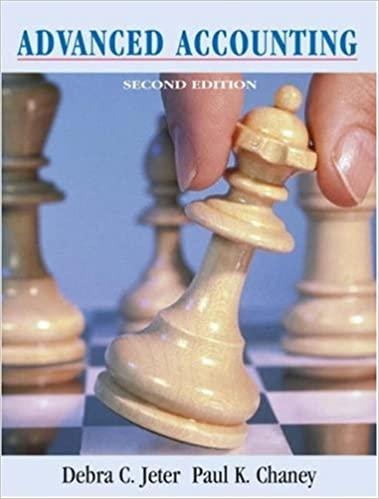Starfax, Inc., manufactures a small part that is widely used in various electronic products such as home computers. Results for the first three years of operations were as follows (absorption costing basis): Sales Cost of goods sold Gross margin Selling and administrative expenses Net operating incone (loss) Year 1 Year 2 Year 3 $ 832,000 $ 665,600 $ 832,000 603,200 416,000 644,800 228,800 249,600 187,200 197,600 187,200 176,800 $ 31,200 $ 62,400 $ 110,400 In the latter part of Year 2, a competitor went out of business and in the process dumped a large number of units on the market. As a result, Starfax's silles dropped by 20% during Year 2 even though production increased during the year. Management had expected sales to remain constant at 52,000 units; the increased production was designed to provide the company with a buffer of protection against unexpected spurts in demand. By the start of Year 3, management could see that it had excess inventory and that spurts in demand were unlikely. To reduce the excessive inventories, Starfax cut back production during Year 3, as shown below: Year 2 Year 3 Production in units 52,000 62,400 41,600 52,000 41,600 52,000 Year 1 Sales in units Additional information about the company follows: a. The company's plant is highly automated. Variable manufacturing expenses (direct materials, direct labor, and variable manufacturing overhead) total only $2.00 per unit, and foved manufacturing overhead expenses total $499,200 per year. b. A new fixed manufacturing overhead rate is computed each year based on that year's actual fixed manufacturing overhead costs divided by the actual number of units produced. c. Variable selling and administrative expenses were $1 per unit sold in each year. Fixed selling and administrative expenses totaled $141,600 per year. d. The company uses a FIFO inventory flow assumption (FIFO means first in first-out. In other words, it assumes that the oldest units in 141,DUU per yedi. d. The company uses a FIFO inventory flow assumption (FIFO means first-in first-out. In other words, it assumes that the oldest units in inventory are sold first.) Starfax's management can't understand why profits doubled during Year 2 when sales dropped by 20% and why a loss was incurred during Year 3 when sales recovered to previous levels. Required: 1. Prepare a variable costing income statement for each year. 2. Refer to the absorption costing income statements above. a. Compute the unit product cost in each year under absorption costing. Show how much of this cost is variable and how much is fixed. b. Reconcile the variable costing and absorption costing net operating income figures for each year. 5b. If Lean Production had been used during Year 2 nd Year 3, what would the company's net operating income (or loss) have been in each year under absorption costing? Complete this question by entering your answers in the tabs below. Reg 1 Reg 2A Reg 28 Reg 58 Prepare a variable costing income statement for each year. Starfax, Inc. Variable Costing Income Statement Year 1 Year 2 Year 3 Variable expenses Starfax, Inc. Variable Costing Income Statement Year 1 Year 2 Year 3 Variable expenses Total variable expenses 0 0 0 Fixed expenses Total foxed expenses Net operating income (loss) Oo 0 0 $ $ 0 $ 0 Reg 1 Reg 2A Req 2B Req 5B Compute the unit product cost in each year under absorption costing. Show how much of this cost is variable and he fixed. (Do not round intermediate calculations and round your final answers to 2 decimal places.) Year 1 Year 2 Year 3 Variable manufacturing cost Fixed manufacturing cost Unit product cost 0.00 $ 0.00 $ $ 0.00 Required: 1. Prepare a variable costing income statement for each year. 2. Refer to the absorption costing income statements above. a. Compute the unit product cost in each year under absorption costing. Show how much of this cost is variable and how much is b. Reconcile the variable costing and absorption costing net operating income figures for each year. 5b. If Lean Production had been used during Year 2 and Year 3, what would the company's net operating income (or loss) have be each year under absorption costing? Complete this question by entering your answers in the tabs below. Reg 1 Reg 2A Reg 28 Reg 5B Reconcile the variable costing and absorption costing net operating income figures for each year. (Enter any losses or deductions as a negative value.) Year 2 Year 3 Reconciliation of Variable Costing and Absorption Costing Net Operating Incomes Year 1 Variable costing net operating income (loss) Add foed manufacturing overhead deferred in inventory Deduct fixed manufacturing overhead cost released from inventory Absorption costing net operating income (los) Required: 1. Prepare a variable costing income statement for each year. 2. Refer to the absorption costing income statements above. a. Compute the unit product cost in each year under absorption costing. Show how much of this cost is variable and how much is fixed. b. Reconcile the variable costing and absorption costing net operating income figures for each year. 5b. If Lean Production had been used during Year 2 and Year 3, what would the company's net operating income for loss) have been in each year under absorption costing? Complete this question by entering your answers in the tabs below. Reg 1 Reg 2A Reg 2B Req 5B es If Lean Production had been used during Year 2 and Year 3, what would the company's net operating income (or loss) have been in each year under absorption costing? Year 1 Year 2 Year 3












